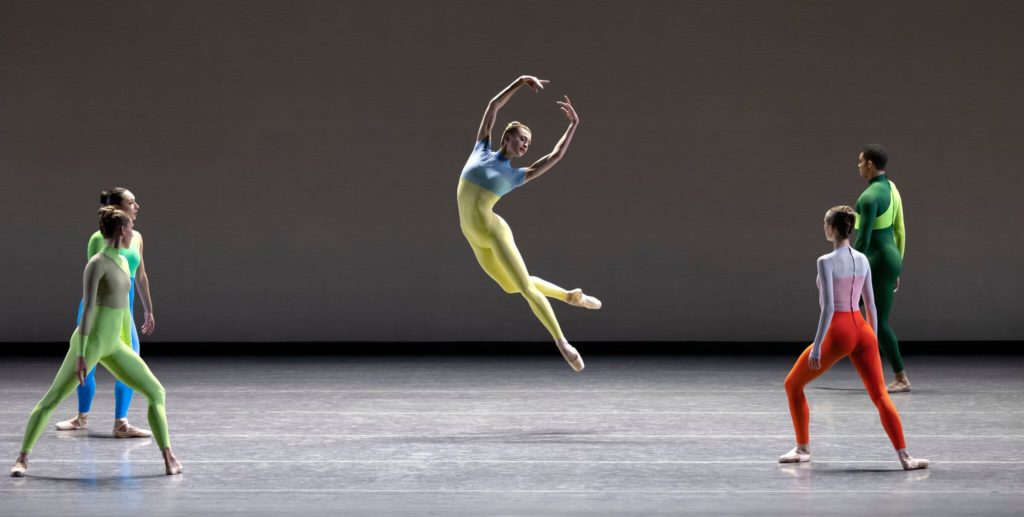THE HANGOVER REPORT – In its current VISIONARY VOICES program, City Ballet features idiosyncratic contemporary works by Tanowitz, Roberts, and Peck
- By drediman
- April 25, 2022
- No Comments

Yesterday at Lincoln Center’s David H. Koch Theater, I caught a Sunday matinee performance by New York City Ballet, which just concluded the first week of its ambitious spring season. The program for the afternoon was part of the company’s “Visionary Voices” series, whose important purpose is to champion the works of contemporary choreographers. This spring’s jam-packed edition feels especially contemporary, with three of the four ballets on the bill having been created over the course of the past few months. The afternoon’s featured choreographers were Pam Tanowitz, Jamar Roberts, and Justin Peck – each of whom have a distinctly idiosyncratic vision of what contemporary ballet can be.
Arguably, the centerpiece of the program is its opener, the world premiere of Tanowitz’s Law of Mosaics, which is set to Ted Hearne’s unsettling string score of the same name. Upon first impression, the 40-minute piece – which looks striking with its sleek but colorful unitard costumes and bold lighting design – comes across as rambling and directionless, altogether rejecting any discernible logic and formula (which may be the choreographer’s intention). In her new work, Tanowitz – as intellectual as always – seems to be experimenting with the utter deconstruction of classical ballet, as if eager to unlock new frontiers and emotional textures hidden within familiar ballet steps. The piece exudes Tanowitz’s recognizably formal and severe aesthetic, which at times seems, as in Merce Cunningham’s works, incongruous with the music. Coming off most memorably are two of the company’s most regal dancers – up-and-coming Miriam Miller and the great Sara Mearns, who ends the piece with a barefoot solo that’s as mysterious as it is strangely compelling.
Law of Mosaics isn’t the only Tanowitz piece is featured. Also on the program is the choreographer’s Gustave le Gray No. 1, which joins the company’s repertory for the first time this spring. The symmetric ballet shows audiences a softer, more accessible (but still rigorous) side of Tanowitz’s choreography. Set to Caroline Shaw’s beautiful, haunting piano score, the work’s four dancers – at my performance, City Ballet’s Daniel Applebaum and Naomi Corti, and Dance Theatre of Harlem guests Anthony Santos and Alexandra Hutchinson (each were clad in striking red costumes whose billowing fabric seemed an extension of the choreography) – are tasked to be detached keepers or guardians of the music of sorts. At one point, they even protectively guide the grand piano across the stage, all the while keeping a watchful eye on the pianist and his playing. Interestingly, this smooth and caressing transition is in stark juxtaposition to the general rhythmic quality of the steps.
The program also includes two works that had their premieres during the company’s winter season – Jamar Roberts’ Emanon – In Two Movements and Justin Peck’s Partita. In its premiere presentation, Emanon was performed to a recorded track of Wayne Shorter’s breezy jazz score, thereby dampening the immediate impact and spontaneity of the ballet. Seeing it again danced to live music-making, the piece unsurprisingly feels much more vital. Throughout, Roberts’ sweeping movements accent the music with undeniable joy and beauty, imploring us to embrace life while we have it. In the work’s latter half, however, a certain level of simplicity and sameness that settles in, which is not to any fault of the dancers (Jovani Furlan was especially vibrant).
Peck’s piece, however, seems just as captivating as when I first encountered it a few months ago. Set to Caroline Shaw’s gorgeous a cappella score – with strong undercurrents of sacred choral music and flashes of spoken word – the work puts the sacred side-by-side with the mundane (Partita, after all, is a “sneaker” ballet, but it does not feel like one) to fascinating effect, inspiring viewers to seek the divine in their everyday lives. When the work premiered during City Ballet’s winter season, the score was stunningly performed live by the vocal ensemble Roomful of Teeth. Although yesterday’s performance was performed to a recorded rendition of Shaw’s score (the unfortunate inverse of what has transpired with Roberts’ dance), it thankfully only slightly detracted from the experience.
There are two more available opportunities to catch this “Visionary Voices” program (it is being performed again on April 29 and May 1).
RECOMMENDED
NEW YORK CITY BALLET: VISIONARY VOICES
Dance
David H. Koch Theater
2 hours, 30 minutes
In repertory through May 1

 Copyright © 2025
Copyright © 2025
Leave a Reply